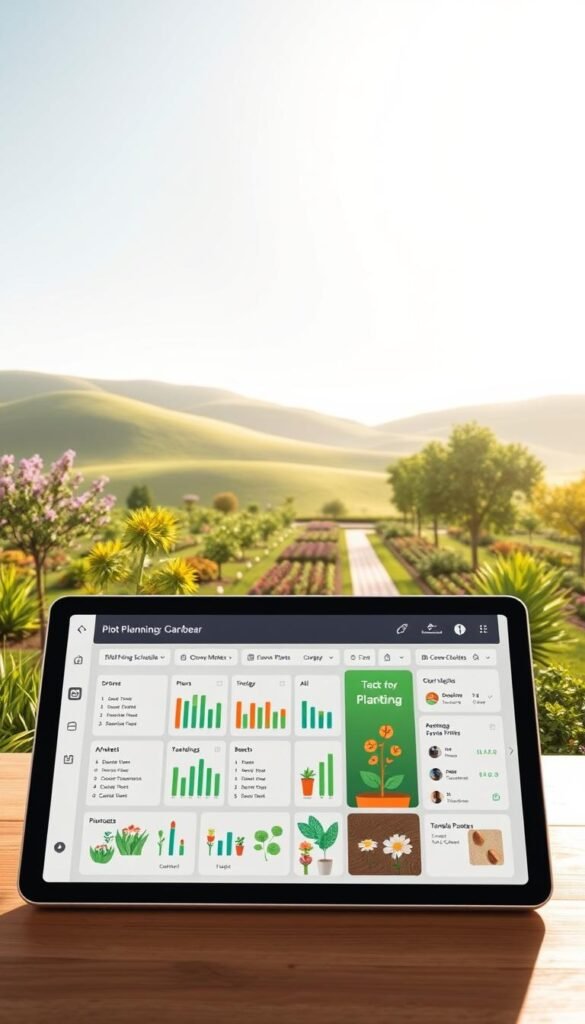That first warm breeze of spring stirs excitement in every gardener’s heart. Gone are the days of scribbled notes on scrap paper – today’s cultivators use digital solutions to design flourishing landscapes. These innovations help you nurture plants with precision while celebrating nature’s rhythms.
Imagine replacing guesswork with clear visual layouts. Advanced tools now map sunlight patterns, suggest companion plants, and predict harvest timelines. You’ll see how data-driven methods simplify crop rotations and space management, whether tending herbs on a fire escape or tomatoes in raised beds.
Earth-friendly practices take center stage as we approach Earth Day 2025. Modern systems highlight water conservation tips and pollinator-friendly layouts. They turn seasonal adjustments into actionable steps, helping you adapt to weather shifts without stress.
These approaches aren’t just about productivity – they deepen your connection to the soil. Detailed progress logs let you celebrate each sprout while learning from challenges. You’ll discover how blending technology with tradition creates spaces that nourish both people and ecosystems.
Ready to transform how you cultivate? Whether growing flowers or food, the right tools make every decision intentional and every effort rewarding.
Introduction to the New Era of Garden Planning
As seasons shift, so do the tools that help us cultivate thriving green spaces. Modern methods blend time-tested techniques with digital precision, turning chaotic plots into organized ecosystems. This approach lets you work with nature rather than against it.
What Is Smart Garden Planning?
Think of it as a personal assistant for your soil. These systems analyze your location’s frost dates, sunlight hours, and soil quality. They then suggest ideal planting times and compatible species. Automated alerts remind you when to water or harvest, while progress photos show your plants’ journey from seed to fruit.
Why Upgrade Your Garden Planner Today?
Paper sketches can’t adjust for sudden heatwaves or downpours. Digital platforms update recommendations based on real-time weather data. You’ll waste fewer seeds, avoid overcrowding, and maximize every square foot. Historical records from previous years help refine your strategies, creating a cycle of continuous improvement.
Earth-conscious features stand out too. Many tools calculate water needs to prevent overuse and suggest native plants to support local wildlife. This isn’t just about bigger harvests – it’s about growing responsibly while enjoying the process more than ever.
Transitioning from Traditional to Digital Garden Planning
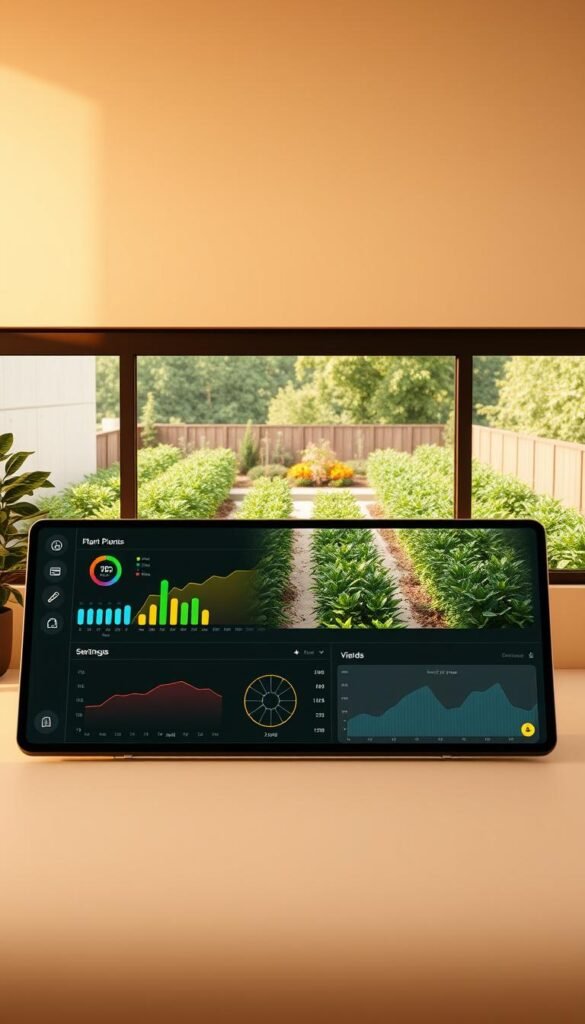
Remember that crumpled napkin with last year’s planting notes? Many growers cherish these handwritten relics but crave better organization. The shift to digital methods keeps the heart of cultivation alive while adding precision to every decision.
From Sketches on Napkins to Advanced Tools
Paper plans often led to overcrowded beds or forgotten varieties. Digital tools fix these issues while keeping what works. They transform coffee-stained sketches into adjustable layouts that evolve with your needs.
Why make the switch? Consider these improvements:
| Aspect | Traditional | Digital |
|---|---|---|
| Edits | Erase marks | Drag-and-drop design |
| Calculations | Manual math | Automatic spacing |
| Weather | Guesswork | Live forecasts |
| Records | Misfiled papers | Cloud storage |
Some worry screens disconnect them from the soil. In reality, these tools free up time for hands-on care. Start by snapping photos of existing layouts – most apps convert them into editable templates.
Keep what you love about paper planning while embracing error alerts and growth trackers. Your green thumb gets smarter, not softer.
Building Your Garden Layout and Design Strategy
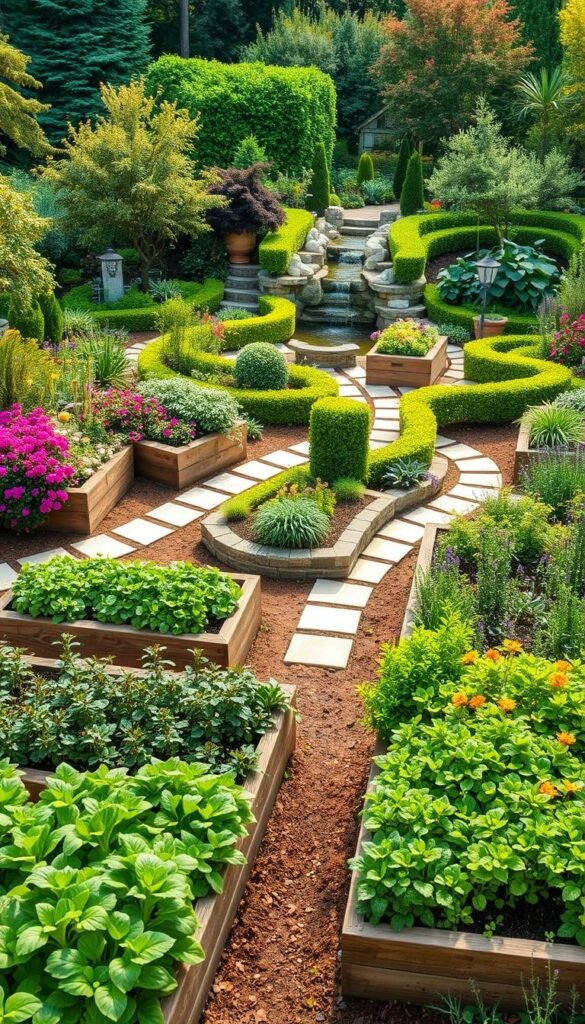
Creating your green space becomes an art form when you blend practicality with nature’s patterns. Modern solutions transform blank plots into thriving ecosystems through intelligent arrangement. Let’s explore how to craft layouts that boost both beauty and harvests.
Understanding Layouts and Zones
Start by mapping sunlight patterns and soil types across your space. Most apps divide areas into zones based on plant needs – full-sun veggies here, shade-loving herbs there. This prevents overcrowding and matches species to their ideal conditions.
Raised beds work wonders for drainage, while in-ground plots suit sprawling crops like squash. Mix containers along pathways for herbs or flowers. Tools like GrowVeg auto-adjust spacing as you drag plants into your digital blueprint, ensuring roots have room to breathe.
Incorporating Companion Planting and Spacing Tips
Tomatoes thrive near basil but wilt next to potatoes. These partnerships matter. Apps highlight which pairs share nutrients or repel pests naturally. You’ll see why marigolds edge vegetable beds and why onions protect carrots underground.
Proper spacing prevents disease spread and simplifies weeding. Tall plants go northward to avoid shading others. Leave walking paths wide enough for harvest baskets. Your USDA zone guides frost dates so tender seedlings aren’t planted too early.
With these strategies, your garden design becomes a living map that evolves through seasons. You’ll nurture plants where they’ll prosper most while creating visual harmony.
Essential Features to Look for in Garden Planning Tools
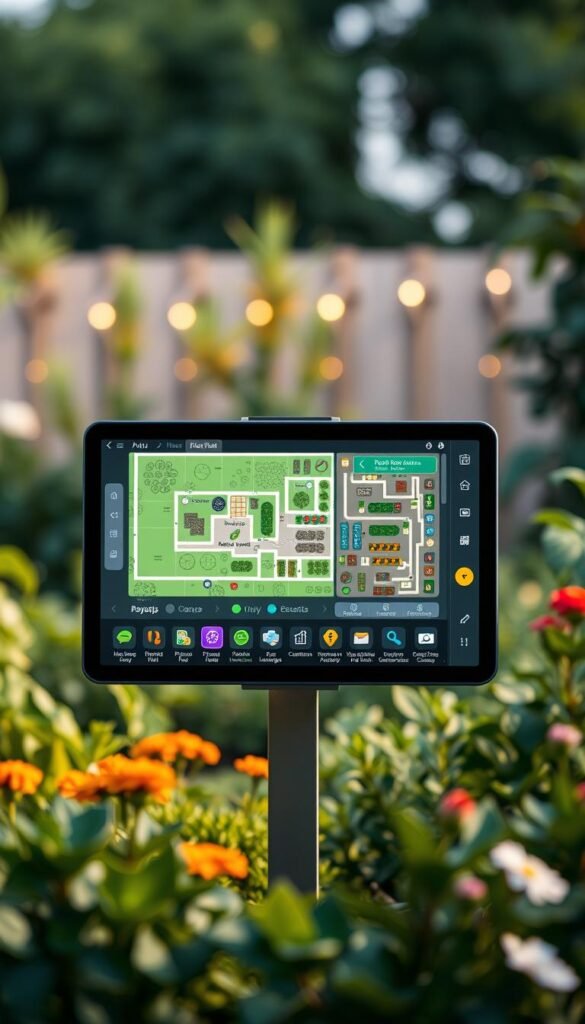
Choosing the right digital assistant for your green space starts with understanding what makes these tools truly effective. Let’s break down the elements that separate basic apps from game-changing partners in cultivation.
User-Friendly Interfaces for Easy Planning
A cluttered interface can turn excitement into frustration. Top platforms use color-coded grids and simple drag-and-drop actions. Look for these features:
| Feature | Why It Matters |
|---|---|
| Visual Layouts | See plant spacing instantly |
| Undo Button | Fix mistakes quickly |
| Tooltips | Learn while designing |
Menus should feel intuitive, like your favorite recipe app. If you need tutorials just to place a tomato plant, keep searching.
Customizable Templates and Regional Planting Calendars
Pre-made designs jumpstart your creativity. One user shared:
“The basil-and-tomato template transformed my patio pots into a pizza garden!”
Regional calendars prove vital. A beginner’s checklist becomes useless if it suggests planting dates for Florida when you’re in Maine. Great tools auto-adjust using your ZIP code’s frost dates and soil data.
Look for databases with filter options – sort plants by sun needs or growth time. This turns overwhelming choices into manageable lists. Your planning becomes precise, not puzzling.
Top Garden Planning Apps and Tools – A Product Roundup
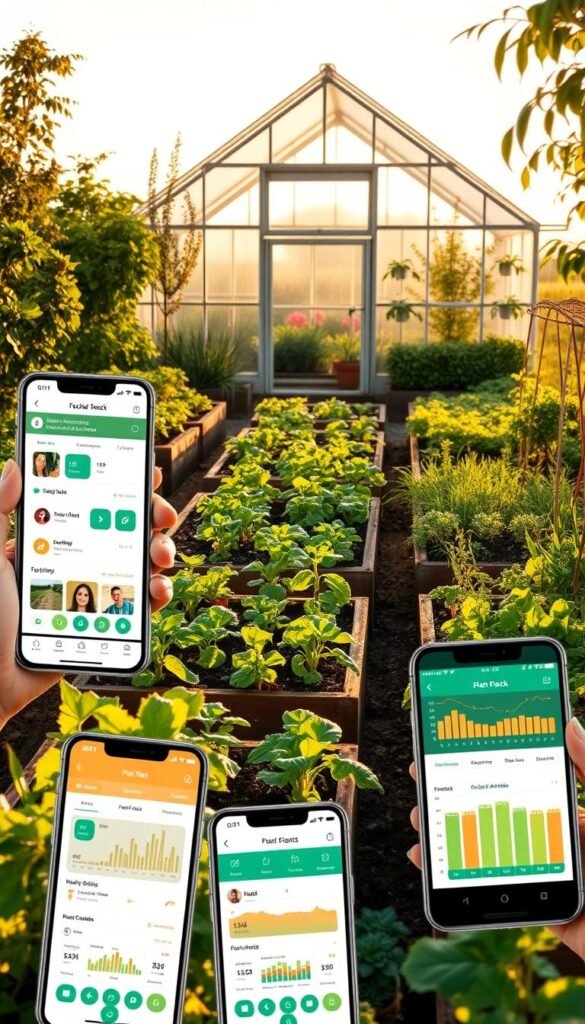
Ever wonder which digital tools truly transform how you cultivate your green space? Let’s explore three standout options that blend innovation with practicality.
GrowVeg, Planter, and The Old Farmer’s Almanac
GrowVeg shines for vegetable enthusiasts. Its drag-and-drop interface simplifies crop rotations while tracking soil health. You’ll appreciate region-specific calendars that adjust planting dates based on local frost patterns.
Planter makes design effortless with color-coded grids. Automatic spacing guides prevent overcrowding, and companion planting alerts help you avoid problematic pairings. It’s perfect for beginners craving simplicity without sacrificing depth.
| Feature | GrowVeg | Planter | Old Farmer’s Almanac |
|---|---|---|---|
| Plant Database | 1,200+ species | 500+ varieties | 700+ entries |
| Specialty | Crop rotation | Spacing guides | Historical data |
| Trial Period | 7 days | 14 days | 30 days |
The Old Farmer’s Almanac Garden Planner merges centuries of wisdom with zip-code precision. Its planting calculator considers moon phases and traditional frost dates – ideal for those valuing heritage methods.
Integrating Digital Journals for Tracking Progress
Most garden planning apps now include journal features. Snap photos of sprouting seeds or note pest issues directly in the app. Over time, these records reveal patterns – like which tomato varieties thrive in your microclimate.
Many platforms offer free trials, letting you test tools risk-free. One user shared:
“The Almanac’s journal helped me spot early blight signs – saved my entire crop!”
Whether you prioritize historical insights or modern design, there’s a garden planner matching your needs. Start exploring today – your most organized season awaits.
Smart Garden Planning: Track Growth, Yields, and Seasonal Changes
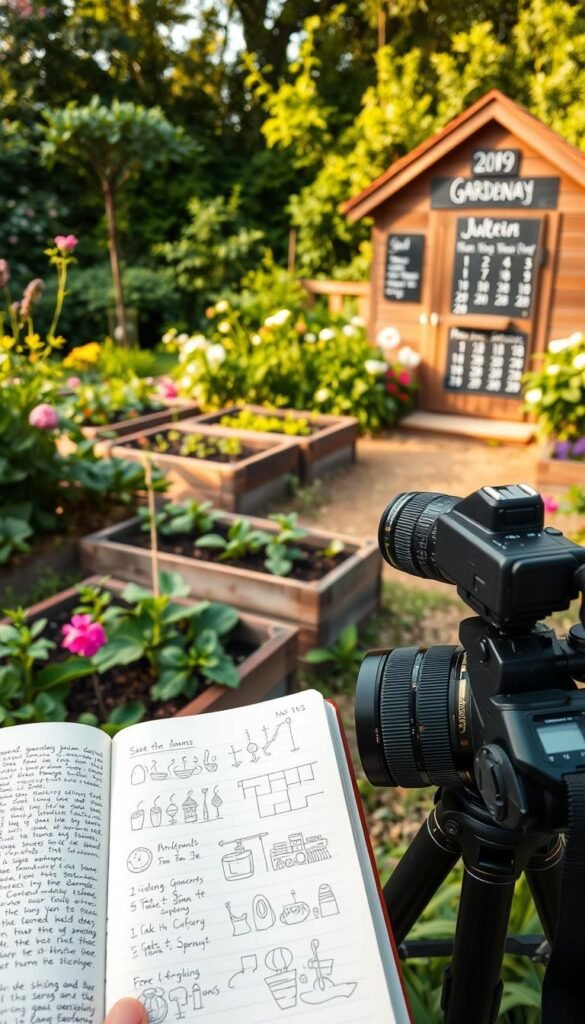
Your thriving green space deserves more than memory-based care. Digital journals turn casual notes into powerful patterns, helping you spot what works. One user noted:
“Recording blossom dates revealed my zucchinis needed afternoon shade – now they’re thriving!”
| Focus Area | Tools | Outcome |
|---|---|---|
| Plant Development | Growth stage photos | Identify slow starters |
| Harvest Results | Weight/quantity logs | Compare varieties |
| Weather Impact | Rainfall tracker | Adjust watering |
Apps like From Seed to Spoon simplify this process, automatically generating progress reports. Studies show gardeners using these tools achieve 70% higher success rates by spotting trends early.
Your records become a personalized playbook. Notice peppers struggle in clay soil? Next season, try raised beds. Track which tomato types resist pests best through your vegetable garden planner apps history. These insights help allocate space and resources wisely.
Consistent tracking builds resilience against unpredictable weather. When frost threatens earlier than usual next year, your historical data guides protective measures. You’ll nurture with confidence, knowing each decision stems from proven experience.
Maximizing Your Garden with Digital Scheduling and Journaling
Technology now acts as your 24/7 cultivation partner, streamlining tasks while honoring nature’s timing. These tools eliminate calendar chaos by syncing with your local environment and plant needs.
Smart Reminders and Weather Syncing
Imagine your phone buzzing just as clouds gather overhead. Apps like Planta analyze forecasts to pause watering alerts when storms approach. One user shared:
“Gardenate’s transplant reminders saved my seedlings from a surprise frost!”
Key features to seek:
| Feature | Benefit |
|---|---|
| Rain Delay Alerts | Prevents overwatering |
| Frost Warnings | Protects tender plants |
| Growth Stage Timers | Matches care to plant maturity |
Recording Milestones with Digital Journals
Snap photos of first blooms or jot down pest solutions in apps that organize entries by date. Over time, these logs reveal patterns – like which varieties thrive in partial shade. Platforms like Seedtime even generate visual timelines showing your green space’s evolution.
Consistent tracking helps you refine techniques. Notice peppers yield more in raised beds? Next planting season, expand those areas. Your documented journey becomes a personalized guidebook, turning trial and error into proven success.
Eco-Conscious Gardening and Earth Day 2025 Inspirations
This year, Earth Day celebrations bring a tech-savvy twist to backyard sustainability. Digital tools now empower you to cultivate spaces that nourish both people and pollinators. Imagine apps suggesting native species that thrive in your soil while supporting bees and butterflies—no guesswork required.
Sustainable Planting Practices
Modern garden planning platforms simplify eco-friendly choices. They recommend drought-resistant plants for dry regions or water-saving layouts for areas like zone 9, where heat demands smart irrigation. Composting guides turn kitchen scraps into nutrient-rich soil amendments, reducing waste naturally.
Earth Day 2025 initiatives highlight habitat creation. Tools like iNaturalist identify beneficial insects, helping you design gardening spaces that double as wildlife corridors. Pairing vegetables with pollinator-attracting flowers boosts yields while aiding ecosystems.
Adopt permaculture principles through digital journals that track crop rotations and companion pairings. These systems alert you when to plant cover crops or switch to organic mulch. Your green space becomes a living tribute to planetary care—one seed, one season, one Earth Day at a time.

